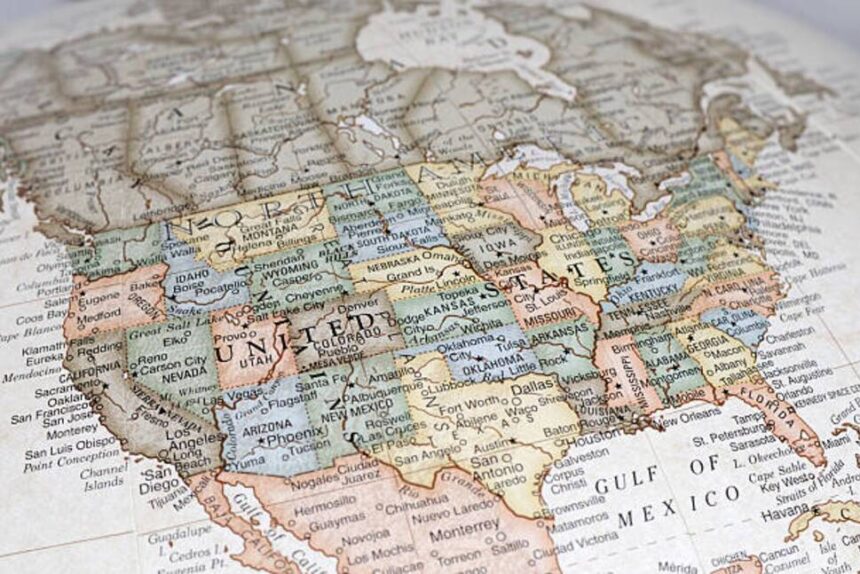Key Takeaways
- Analyzing an applicant’s geography is one way colleges can ensure diverse classes.
- State funding incentivizes public schools to admit more in-state applicants.
- Applicants may stand out more when applying to highly selective schools outside their region.
Where an applicant lives and attends high school has long been one of many factors that college admissions officers consider. Colleges want to build a diverse student body, and geographical information can give context about an applicant’s academic curriculum and the cultural diversity they can bring to the school, experts say.
The 2023 U.S. Supreme Court ruling against the use of race in college admissions has placed increased significance on geography in applications, says Colleen Paparella, founder of DC College Counseling.
“That’s one way they can legally shoot for a more diverse group of kids,” she says. “When you take away race, zip codes provide a sense of diversity. It’s usually socioeconomic, but there can be cultural and racial diversity as well.”
Other factors such as a student’s GPA, high school course rigor, extracurricular activities and letters of recommendation still hold the most weight in college admissions decisions, but experts say applicants should understand how geography may affect their admissions chances – as well as where they choose to apply.
How Public and Private Colleges View Geography
Both public and private schools generally look for qualified and diverse candidates locally and nationally. But public colleges typically do so by filling their classes with mostly in-state students.
This is largely due to funding, experts say. Public schools are obligated to serve the students who live in their state, says Stefan Hyman, associate vice president for enrollment management at San Diego State University in California. For example, state policy requires SDSU to give highest admission consideration to students within their “local area,” which includes San Diego County and nearby communities.
SDSU received about 90,000 first-year applications for the 2024-2025 academic year. About 10% of those were from students from the local area, and those students will make up about one-third of the roughly 6,500 admitted students, Hyman says.
“We’re not getting state funding for educating out-of-state students,” he says. “That’s why the tuition is a lot higher for out-of-state students, because they’re making up for not having parents who are paying into the tax system that ultimately drives our state appropriations.”
Other states have similar laws that incentivize public schools to recruit most heavily in their own backyard, Paparella says. “In those states, it becomes much more difficult for out-of-state students to get in.”
Private schools aren’t bound by such stipulations, so their first-year student classes tend to be more nationally diverse.
“As a national and global institution we know that your hometown shapes you, and we think that’s a good thing,” Adam Sapp, assistant vice president and director of admissions at Pomona College, a private school in California, wrote in an email. “We take a lot of pride in knowing that our students come from a range of big cities, small towns and places in between.”
Most highly selective private colleges recruit from “pipeline” areas – cities and regions that typically produce the type of student they’re looking for. In some cities, particularly large metropolitan areas like New York City, Los Angeles, Chicago and San Francisco, many students apply to a similar list of highly selective private colleges that recruit the region heavily. That’s especially true among students who attend highly ranked high schools, experts say.
But that could be changing in the wake of the Supreme Court ruling, says John Morganelli Jr., director of college admissions at admissions consulting firm IvyTutors.
“You’re going to see a change in the distribution of offers away from classical feeder schools because there’s just no way you’re going to get the diversity numbers you want by taking the exact same students from the exact same schools,” says Morganelli, who previously served as director of admissions at Cornell University in New York.
But until that tide fully shifts, it may remain difficult for students in certain areas to stand out when many of their classmates are applying to similar schools. Schools looking to build a diverse class may reject qualified students from that pool of applicants in order to accept others from a different region or country.
That doesn’t mean students shouldn’t apply to those schools if that’s where they want to go, but experts say students should also consider applying to a prestigious private school that doesn’t tend to attract many applicants from their region.
“If you live in, say, Arkansas or Kansas, there might be fewer students who have aspirations of wanting to go to certain top-tier colleges or Ivy League schools,” says Christopher Rim, CEO and founder of admissions consulting company Command Education. “You have a much better chance of getting in if you’re in a state that might be in a more rural area. If you’re not in a major metropolitan city, your competition is much less.”
It’s important for students to attend a high school that fits them best academically and socially, experts say, but families shouldn’t feel compelled to move far away to find that school. It doesn’t always help admissions chances, and moving to a more competitive high school may hurt an applicant’s admissions prospects at some colleges, Morganelli says.
Instead, he encourages students in rural schools to embrace their background and experiences in their application. “It all adds to the difference in the perspective of the student,” he says. “Colleges want distribution of perspective so they can have a broad learning community that can valuably add to the context of intellectual study at the university.”
Finding the Right Fit
Students should make sure they’re going to be a good fit academically and culturally wherever they attend college, especially if it’s out of state or in an unfamiliar city, Hyman says.
Applicants should also understand that their high school’s curriculum may affect which schools are feasible to apply to. If students have decided on a major, they should confirm that their prospective college offers it and that their high school curriculum aligns with that school’s major requirements.
Additionally, students who take dual credit courses often earn those credits through a local or regional university that may have agreements with in-state schools to accept those credits. There’s no guarantee a school in a different state will do so.
For example, California universities require students to meet “A to G” requirements, which include 15 yearlong core classes as well as a foreign language, visual and performing arts and a college preparatory elective. Each letter represents a different discipline and there’s a certain number of required classes within each discipline.
“Sometimes, those disciplines and the curriculum don’t match up to the core curriculum in every other state that students might be applying from,” Hyman says. “Sometimes there are trivial differences, but sometimes there might be metered differences.”
While an applicant’s geography matters, it’s important to remember that admissions decisions are based on many factors, Rim says. Whether students live in a metropolitan or rural area, admissions officers want to see that applicants challenged themselves with the most rigorous curriculum available and made the most of available extracurricular opportunities.
Admissions offices will glean some of this by accessing the high school profile, but students can further explain their high school and geographical context in their application.
“Do some thinking and reflecting on how your hometown and school community has shaped you,” Sapp says, “and plan to use those reflections and ideas when you tell your story to colleges and universities, particularly when you write your application essays.”











